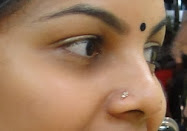Stainless steel, 14\18 carat gold, titanium, nickel or niobium are the metals that nose rings / mukuthi are generally made from. Nickel can cause allergic reactions often in the form of rashes or sensation of burning around the area of the nose ring / mukuthi. So remember, if it does not suit you, do consider an alternative metal. Sometimes, gems are glued on to the nose rings. The chances are that the gems will fall out sooner or later, so ensure that they are mechanically set.
Strangely enough, calves are also made to wear nose rings / mukuthi. However, the purpose is not ornamental. They are meant to successfully wean the calf. The nose rings / mukuthi interfere with the feeding process frustrating both the calf and the cow. When this happens often, the calf gets used to the idea of not being able to feed and is successfully weaned without going through the trauma of separation.





No comments:
Post a Comment